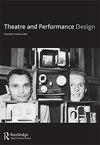Editors’ introduction
Q2 Arts and Humanities
引用次数: 0
Abstract
The Austro-American architect and scenographer Frederick Kiesler’s 1942 exhibition, Art of this Century, for Peggy Guggenheim’s New York gallery, shockingly (and maybe for the first time since the baroque Wunderkammer displayed polyphonic assemblages of quirky objects of desire) understood exhibition objects to be elements of an environment that was inseparable from the exhibition space itself. In Art of this Century, Kiesler not only curated the exhibits but rather reconfigured the gallery space and designed biomorphic seating and kinetic hanging constructions that enabled the visitor to view the exhibits from all angles. Kiesler’s spatial dramaturgy and exhibition scenography offered a heterogenous parcourse, a non-linear navigation and, overall, the visitor’s complete immersion into the world of surrealist and abstract artistic imagination. This special double issue, titled ‘Staged: Scenographic Strategies in Contemporary Exhibition Design’, shows that in today’s exhibitions, again, the scenographer holds a special place as the author of an environment rather than as the skilful ‘placer’ of objects. The articles in this issue, which is conceptualised and curated by UK-based academics Greer Crawley and Lucy Thornett, demonstrate that contemporary exhibition scenographers, while resisting harmonising narratives, nevertheless embrace the creation of distinct atmospheres by employing a wide range of strategies successfully tested over centuries of theatrical stagecraft and now reimagined with contemporary media, lighting and visualisation technologies and materials. Today, the scenographer enters the gallery, the museum or exhibition hall as dramaturg, architect, as product, light, audio and olfactory designer, not with the pragmatic aim to display and present individual artefacts but rather to create a composition of all the material and immaterial elements that make up what we call scenography in and beyond the theatre. In its totality, this composition – or better: this scenography – performs the action of a discursive staging of space that can critique both process and outcome. The concept of staging has been described as one of ‘presencing’, that is, a production of presence that, as Hans Ulrich Gumbrecht posits, ‘endows the object of aesthetic experience with a component of provocative instability and unrest’ (2004, 108) as cited by Ken Wilder in this issue. Extrapolated from Gumbrecht, and with recourse to the articles curated by Crawley and Thornett, one may now see not only the individual object but conversely the environment as being productively destabilised by the act of staging, through scenography. Thus, we may conclude that in a staging specific to exhibition design, elements of the theatre, of architecture, media and installation, converge to form a complex narrative, transformative and immersive scenography that both envelops and, importantly, activates the visitor and opens the physical environment to a critical and discursive experiential reading. We are delighted not only by the quality of the articles that Greer Crawley and Lucy Thornett have brought together for this special double issue but also the diverse international reach of the journal that it represents, with authors from South America, Europe, India, Australia and the UK. We extend our thanks to our guest editors for suggesting this topic and for their diligence and excellent work in bringing it all together. In addition to the articles, our regular编辑的介绍
1942年,澳大利亚建筑师和舞台设计师弗雷德里克·基斯勒(Frederick Kiesler)为佩吉·古根海姆(Peggy Guggenheim)的纽约画廊举办了名为“本世纪艺术”(Art of this Century)的展览,令人震惊的是(这可能是自巴洛克风格的Wunderkammer展出古怪欲望物品的复调组合以来的第一次),他把展览对象理解为与展览空间本身密不可分的环境元素。在《本世纪的艺术》中,Kiesler不仅策划了展品,还重新配置了画廊空间,设计了生物形态的座位和动态的悬挂结构,使参观者能够从各个角度观看展品。Kiesler的空间戏剧和展览布景提供了一个异质的通道,一个非线性的导航,总的来说,游客完全沉浸在超现实主义和抽象艺术想象的世界中。这期名为《舞台:当代展览设计中的场景策略》的特刊再次表明,在今天的展览中,场景设计者作为环境的作者而不是作为物品的熟练“放置者”占据着特殊的位置。本期由英国学者格里尔·克劳利和露西·索尼特构思和策划的文章表明,当代展览舞台设计师在抵制协调叙事的同时,通过采用广泛的策略来创造独特的氛围,这些策略在几个世纪的戏剧舞台艺术中得到了成功的测试,现在用当代媒体、照明和可视化技术和材料进行了重新构想。今天,舞台设计师以戏剧设计师、建筑师、产品、灯光、声音和嗅觉设计师的身份进入画廊、博物馆或展厅,他们的目的不是展示和呈现单个的人工制品,而是创造一种由所有物质和非物质元素组成的组合,这些元素构成了我们所谓的剧院内外的舞台设计。总的来说,这种构图——或者更好地说:这种场景——执行了一种空间的话语舞台,可以批判过程和结果。舞台的概念被描述为一种“存在”,也就是说,正如汉斯·乌尔里希·冈布雷希特(Hans Ulrich Gumbrecht)所假定的那样,“赋予审美经验的对象一种挑衅性的不稳定和动荡的成分”(2004/108),正如肯·怀尔德(Ken Wilder)在本期中引用的那样。根据Gumbrecht的推断,并借助Crawley和Thornett策划的文章,人们现在不仅可以看到个体对象,还可以看到相反的环境,因为通过场景设计的舞台行为而产生不稳定。因此,我们可以得出这样的结论:在一个特定于展览设计的舞台中,剧院、建筑、媒体和装置的元素汇聚在一起,形成了一个复杂的叙事、变革和沉浸式的场景,既包围了游客,更重要的是,激活了游客,打开了物理环境,让他们进行批判性和话语性的体验阅读。我们感到高兴的不仅是Greer Crawley和Lucy Thornett为这期特别的双刊所汇集的文章的质量,还有它所代表的期刊的多样化的国际影响力,作者来自南美、欧洲、印度、澳大利亚和英国。我们感谢我们的客座编辑提出这个话题,感谢他们的勤奋和出色的工作。除了文章,我们的常规
本文章由计算机程序翻译,如有差异,请以英文原文为准。
求助全文
约1分钟内获得全文
求助全文
来源期刊

Theatre and Performance Design
Arts and Humanities-Visual Arts and Performing Arts
CiteScore
0.40
自引率
0.00%
发文量
14
 求助内容:
求助内容: 应助结果提醒方式:
应助结果提醒方式:


